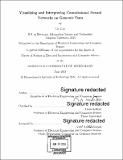Visualizing and interpreting convolutional neural networks on genomic data
Author(s)
Liu, Ge, Ph. D. Massachusetts Institute of Technology
DownloadFull printable version (5.229Mb)
Other Contributors
Massachusetts Institute of Technology. Department of Electrical Engineering and Computer Science.
Advisor
David Gifford.
Terms of use
Metadata
Show full item recordAbstract
Deep learning's capability to learn derived features through a hierarchy of non-linear layers has proven superior to other machine learning methods. However, interpretation of the resulting genomic deep learning networks remains challenging. While many network visualization tools focus on directly mapping high level neuron features into input space, they do not explicitly reflect how a network combines these features when making predictions. Moreover, many of these methods only examine network's response to a specific input sample. This thesis presents DeepResolve, a visualization framework for genomic convolutional neural networks that reveals how combinatorial interactions of sequence features contribute to solve a single genomics task, as well as revealing feature sharing across tasks in a multi-task setting. DeepResolve employs a gradient ascent based method to visualize feature maps in intermediate layers of a network and 1) summarizes overall knowledge of a class contained in a network in an input independent manner, 2) recovers network linear and non-linear combinatorial logic, and 3) reveals class relationships in a multi-task application. DeepResolve is compatible with existing visualization tools and provides complementary insights. We demonstrate the visualization of convolutional neural networks trained on both synthetic and experimental data, and show DeepResolve's capability to recover key sequence features and non-linear logic, and reveal correlation in feature space between uncorrelated genome annotations including histone marks, DNase hypersensitivity, and transcription factor binding that suggest shared biological mechanism.
Description
Thesis: S.M., Massachusetts Institute of Technology, Department of Electrical Engineering and Computer Science, 2018. Cataloged from PDF version of thesis. Includes bibliographical references (pages 49-51).
Date issued
2018Department
Massachusetts Institute of Technology. Department of Electrical Engineering and Computer SciencePublisher
Massachusetts Institute of Technology
Keywords
Electrical Engineering and Computer Science.